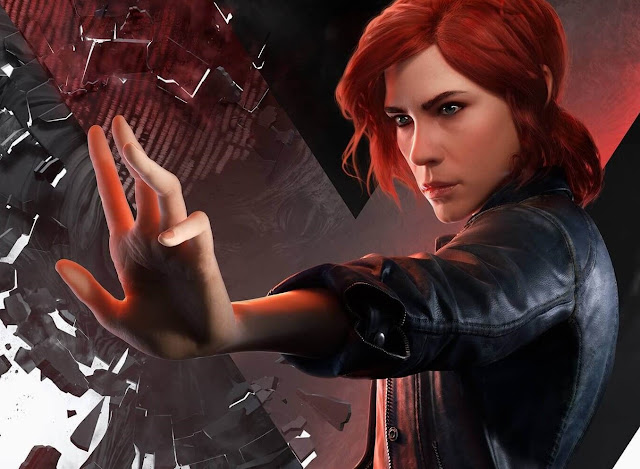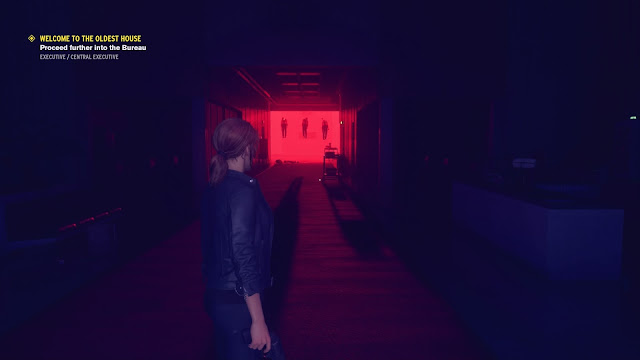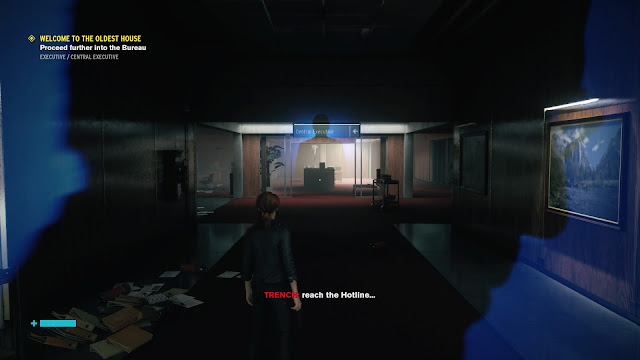Review by Harvard L.
Remedy Entertainment is best described as a purveyor of experimental blockbusters. Not only do its games push the boundaries of gameplay and narrative, but they often literally feature experimentation as a plot theme. This could not be more true for Control, the newest in line to the illustrious legacy of games like Alan Wake and Quantum Break. It’s a science-fiction adventure through a shady government agency known as the Federal Bureau of Control – an office complex in charge of detaining and researching supernatural phenomena: Altered World Events, and Objects of Power. Players take control of Jesse Faden, a woman who stumbles upon the FBC in search of her missing brother, Dylan.
At its core, Control is all about its science-fiction mystery narrative. The game hooks players right off the bat with a salvo of weird mysteries. Jesse finds her way into the building, greeted by an odd janitor who speaks partially in gibberish and might know more than he’s initially letting on. She’s led to the Director of the Federal Bureau of Control’s office, in which she finds the previous boss dead on the floor with a gunshot wound to his head. The smoking gun lays by his side: a transforming pistol known as the Service Weapon made of black obsidian cubes which seemingly shoots pieces of itself. A voice in Jesse’s head tells her to pick up the gun, and with that, she becomes the new Director of the Federal Bureau of Control.
But things are not right: the Bureau, headquartered in a shapeshifting building known as the Oldest House, is under siege from an interdimensional force known as the Hiss, which has been taking over the bodies of employees. The Head of Research, the only person who might provide some insight into the happenings, has gone missing – but not before he manically crafted a number of odd breastplates (named “Hedron Resonance Amplifiers”) which seem to have made its wearers immune to the Hiss’s influence. And then we find out, Jesse has a voice in her head named Polaris, which has been guiding her along since she was a child, when a slide projector suddenly turned rogue and opened portals to other dimensions. And this is just the first chapter – Control is happy to throw mystery after mystery at the player as they spiral deeper into the secretive Oldest House.
Mechanically, Control is a narrative game punctuated with third-person shooter segments. Although the story is very much at the forefront, Jesse will be faced with combat encounters at various moments throughout her journey – some as set piece boss battles and others as random encounters as she wanders the halls. The combat mechanics are fast paced and encourage full use of Jesse’s full arsenal. While games like Bioshock and Dishonored also play with the guns-and-magic-powers idea, those games were more about careful resource management and player empowerment. Control on the other hand is about in-the-moment resourcefulness: the Service Weapon has infinitely regenerating ammunition but needs to recharge after firing a clip, while Jesse’s telekinetic powers recharges using a different resource.
This means that players need to alternate between firing the Service Weapon and flinging objects at foes, picking out priority targets while avoiding overuse of any one offensive option lest it overheat and force the player into hiding. Control does not play well as a cover shooter – enemies are clever and will flank the player whenever possible, so the best defence is to keep moving and neutralise the enemies who pose the most immediate threat. Enemy types are hugely varied and no two action setpieces will ever be the same. They force the player to make a plan on the fly, and Remedy Entertainment isn’t above punishing overaggressive or careless players with a Game Over or two.
Jesse is able to develop her skills using a standard skill tree, gaining stats buffs, unlocking new weapons, and equipping mods to slightly change the firearm’s stats. The Service Weapon can transform into a variety of modes: a pistol, a shotgun, a piercing laser sniper round, and more. Each form has some type of strategic significance, lending the enemy encounters a surprising amount of depth. There has been enough effort on Remedy’s part to keep the combat interesting for the game’s entire run time – you’ll constantly be receiving new options and toys to play with, and combat never grates with the game’s pacing, as was a problem in the studio’s earlier titles.
The game’s structure feels decidedly modern. The Oldest House is designed to be a contiguous space, a kind of open-world adjacent, as opposed to the linear corridors and passageways which we’ve come to expect from narrative-driven shooters. Inspiration is taken from games such as Metroid Prime: areas which are once locked off or inaccessible open up as the game progresses, so that the full experience is at least in part, non-linear. The game is divided up into a number of self-contained departments within the Oldest House, connected by an elevator. Each department is its own space, filled with varied rooms and a core mission which takes Jesse through its winding passageways. As Jesse explores deeper into the house, she will unlock additional psychic powers like the ability to air-dash, to pick up and hurl physics objects, and to levitate for a small duration. These powers shift the way players can approach combat and exploration, opening up shortcuts and further expanding the places that Jesse can go. You’ll also find an impressive amount of supplementary reading material in the form of collectible clipboards, shedding more light into the Bureau’s activities, and even making some fanservicey narrative links to Remedy’s other games. The experience is like reading footnotes in a novel – and viewing these clipboard messages is just as integral to Control’s ludic experience as the shooting and exploring.
The Metroidvania format is particularly well suited for the game’s interior setting. The Oldest House is, upon first impression, an ordinary office building. Care has been taken by the level designers to make things seem as mundane as possible. You’ll quickly realise that this is no mere office, however – parts of the House have hybridised with interdimensional locales, where materials have leaked over from some otherworldly place. Other places function on dream logic, morphing and folding upon itself, refusing to behave like a regular three-dimensional space. This meant that traversing the game’s locales was one of the most intriguing mechanics. There are also small open-world missions: mostly randomly-generated combat scenarios with paltry rewards; they make the building feel more alive (and Jesse’s new position as Director a little more believable) but they can be ignored without much detriment.
One thing you’ll quickly come to notice as you play Control is that Remedy Entertainment love television. It’s always been a quirk that endeared me to the studio – while many developers draw inspiration from the cinematic form, Remedy has always been quite specifically interested in serials, episodes and the structure of a long-paced television drama. The levels and cutscenes are bathed in jarring lighting cues and an otherworldly atmosphere that bears a significant David Lynch influence. Similarly, the non-linear narrative, built upon vignettes and relying on lore and background information, endears a repetitious search for closure reminiscent of a long-running myth-arc TV show.
And then there are the more blunt references: the researcher Casper Darling’s recorded dossiers explaining the inner workings of the Oldest House, the ex-Director Zachariah Trench’s recorded thoughts spoken from a shadowy figure, and even an uncanny puppet show called Threshold Kids which explains the game’s paranormal concepts in a way that a six year old would comprehend, and then be understandably terrified by. As a by-product of television’s more mature storytelling conventions, Control benefits from a nuanced perspective on its characters: rather than re-use the same one-note villains as any other game, Jesse Faden does battle with cosmic forces unleashed by scientists whose motivations you are constantly invited to question, but are never underpinned by labels as simplistic as “good” or “evil”.
The visual sources Control draws from also sheds light on its status within the games industry. TV shows like The X-Files, Lost, Twin Peaks and Fringe, although certainly not underappreciated, are considered cult classics for a reason, and they are neither accessible nor do they have mass market appeal. But each one of these series have moved television as a medium forward a step or two: especially in the case of Twin Peaks and Lost, these shows fundamentally changed the way people regard television. We can see this influence creep slowly into mainstream juggernauts like Stranger Things: by daring to break the mould, the whole medium is advanced as a result.
The team at Remedy evidently has lofty ambitions to do the same with the gaming medium. It’s easy to forget that Alan Wake really pushed things forward at the time, and that Quantum Break, although it’s a more conventional action narrative, is still unmatched in its stunning frozen-in-time action set pieces and its hybridity of game and film. Control feels like the studio has put together lessons learned from each of these games, and yet it doesn’t seem to have the same ambitious high-concept.
Where Control does improve upon its predecessors however, is its conveyance of mood. Alan Wake and Quantum Break both had their profound moments, but both could also be very unintentionally goofy games, whether due to tech failure or to their segregation of combat and narrative. Control works much better in that regard, thanks to a fresh coat of polish in its mechanics. Everything about this game, from its narrative to its combat, its graphical style to its level design, the sound and the writing, contributes to its central mood: a lingering sense of paranoia and mystery. The individual components, although varied, never grate against each other. Combat feels necessary to build tension in the narrative, and to pace out key story cutscenes, but rarely does it become a chore or roadblock to something the player actually wants. Similarly, the story elements provide deeper insight into the nature of the Oldest House, and inform the ways the player explores and handles combat. The game’s stark architecture and muted colour scheme are reminiscent of a Nine Inch Nails music video, and the narrative provides the angst to match. Many of the psychic powers the player unlocks are multipurpose – they are useful both in combat and in traversal, or they might have deeper plot implications. Everything feels thought out and planned, nothing is arbitrary – and in a game with so many unanswered questions, it’s refreshing to see Remedy’s design hold strong in the face of scrutiny.
The result is a game which is utterly fascinating to think about. The juxtaposition between vapid office chatter to interdimensional cosmic horror works to unsettle the player, engendering a thirst for more and more information. You want to push forward to solve the underlying mysteries of the house. You’re convinced that there must be a satisfying answer out there somewhere. Someone tells you there’s a pit filled with mould that tastes like fairy floss and might make you into a zombie? Let’s go, right now. I can’t exaggerate just how much I love the game’s narrative and tone.
My only complaint is that, compared to Remedy’s earlier endeavours, Control feels impersonal. Don’t get me wrong, the game’s characters are amazing and instantly memorable. They just don’t spend a lot of time interacting with each other. Our hero, Jesse Faden, is more taciturn than Remedy’s other leads (incidentally all troubled white men who eagerly brood their problems out) and it’s a shame that we don’t get to hear much of her internal monologue or backstory. Even Faden’s conversations with Polaris are restricted to whatever is directly in front of her. We don’t get much personality outside of her quest to find her brother Dylan, who for most of the game is a person-shaped hole in the narrative, there to create mystery rather than define Jesse’s character.
The side characters on the other hand have excellent personalities crafted through wonderful writing and voice acting: the enigmatic and scatterbrained researcher Casper Darling, the unscrupulous and melancholic ex-Director Zachariah Trench, the eager and vivacious protégé Emily Pope and Ahti, the janitor, practically plaster their personalities all over any scene they are in. But they appear rarely, and they stay locked up in safe-rooms to give you quests and talk to you when you decide to. We aren’t treated to character driven scenes like in Alan Wake, where a washed-up novelist suffering from writer’s block searches for his missing wife among the townsfolk of a sleepy Pacific Northwest village. Instead, we get Jesse Faden, alone – wandering empty hallways and reading fragments of a story others have left behind for her.
I linger so much on the disappointments because to be honest, my expectations for Control were sky-high. I still occasionally think about how brilliant Alan Wake’s narrative was, and out of all studios I trust Remedy the most with a protracted development time. They give the impression of artisans who understand that good narratives take time to plan and percolate. In a landscape filled with feature-laden open-world games which would celebrate 30 minutes of earnest storytelling scattered amongst a vapid, 30-hour campaign, Remedy’s games feel laser focused and refreshing.
For the most part, Control is a resounding success. It carves out a unique identity in its gameplay, and its interconnected story receives the torch passed from previous titles by its studio. It wears its influences on its sleeve, and is all the better for it. Even if the run time is a little shorter than other big budget games, there is a density and richness to Control’s design which is easy to appreciate, and the game tends to linger in your mind for much longer than any other Triple-A game of recent memory. Even if it has its flaws, and even if it left me wanting more, I put down my controller as the credits rolled feeling deeply satisfied: and that’s something we should cherish if we ever want the gaming medium to move forward.
– Harvard L.
Contributor













